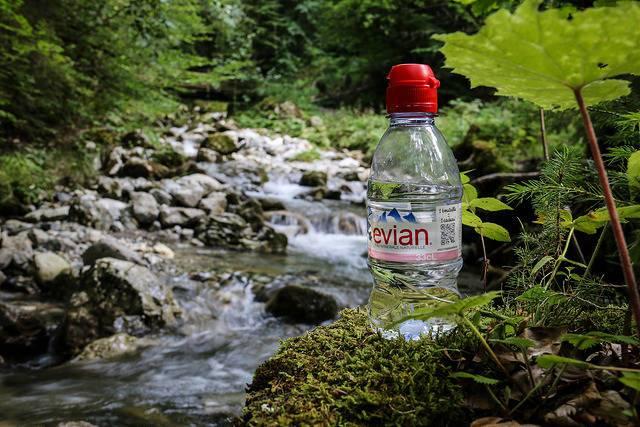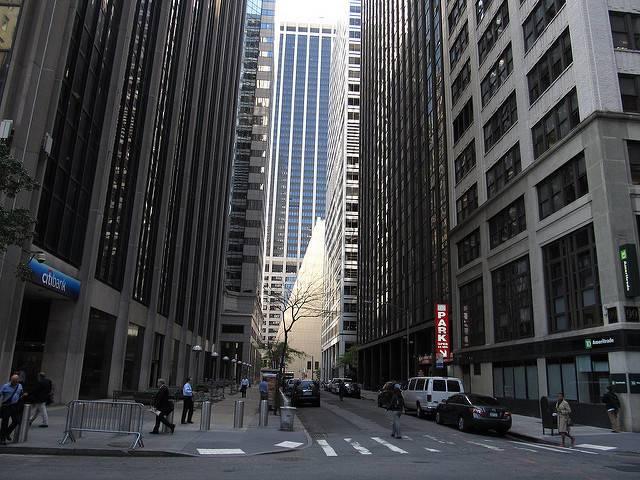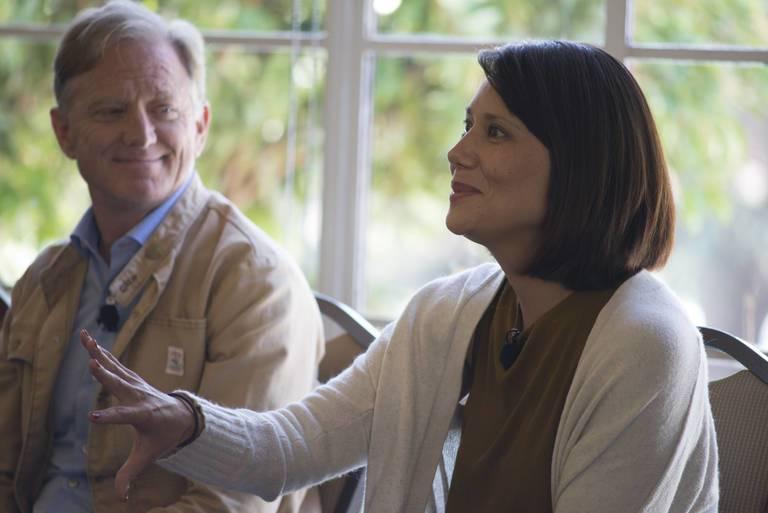All Evian Water Bottles to Be Part of a Closed Loop System by 2025


Evian, the brand that long ago made bottled water chic and opened the door for more competitors to flood the market, announced yesterday that all of its plastic bottles will be made from 100 percent recycled plastic by 2025.
The news was first shared on Twitter by Emmanuel Faber, CEO of Danone, which traces its ownership of Evian back to 1970:
[embed]https://twitter.com/EmmanuelFaber/status/953926604589236225[/embed]
Last year, Evian announced that it would become carbon neutral by 2020.
In order to reach this waste diversion goal, Evian will partner with organizations including The Ocean Cleanup, Ellen MacArthur Foundation and Loop Industries. Aligned with this initiative are programs that will aim to change consumer behavior, boost recycling initiatives and strive to eliminate the plastic trash that is ending up in the world’s oceans at a rapid clip.
The key to this zero waste shift becoming successful is finding the technology that will allow for those pesky PET bottles to be recycled again and again into sturdy new bottles. That is where Loop Industries steps in. Currently, many of the PET bottles that end up in recycling streams end up as fabric or upholstery in their second life. As explained on Fast Company, one huge challenge to expanded PET recycling is that the resulting material in time ends up as a lower grade material, which makes a second life as a consumer product a challenge.
Of course, even if this project comes to fruition in the next seven years, the results still may not mollify critics of the bottled water industry: after all, it still means heavy cases of bottled water will be shipped across the oceans, a journey that leaves behind its own significant carbon footprint.
Nevertheless, a future circular economy that helps reduce the amount of plastic ending up in oceans could improve the reputation of the bottled water industry and conserve some landfill space as well. Every time beverage companies tout their sustainability street cred, critics of the sector repeat what they say is a wide array of problems, from bottled water's cost compared to drinking water straight from the tap to the optics of drawing water in regions affected by drought.
To Evian’s credit, the brand has succeeded at showing that it can function as a more responsible company. Over the years, Evian has redesigned its bottle in a move to reduce the amount of materials consumed by its supply chain. Furthermore, while much of the process involved with the bottling of its water can now rely on automation, the company retrained its workers at one bottling plant so it would not have to reduce its workforce.
Nevertheless, Evian’s move will have to be matched by many companies if the global beverage and bottled water sector can reduce its overall environmental impact. As pointed out last year on publications such as Forbes, the world manufactures one million plastic bottles a minute – hence any closed loop system is going to have to cast an impossibly wide net.
Image credit: Mark Botham/Flickr
McDonald’s Promises 100 Percent Sustainable Packaging by 2025


McDonald’s has come a long way since those infamous Styrofoam clamshell containers of a generation ago.
The world’s largest fast food company announced this week that by 2025, all of its packaging will be made from recycled, renewable or certified sources. McDonald’s was short on specifics, but it said Forest Stewardship Council (FSC) certification will be the preferred standard for such materials; by 2020, the company has pledged that all of its fiber-based packaging will either be recycled or certified and not have any ties to deforestation.
Currently, McDonald’s claims that half of its consumer packaging is made out of recycled, renewable or certified materials, while 64 percent of its fiber-based packaging is derived from certified or recycled sourcing. Worldwide, the company says 10 percent of its restaurants are recycling food packaging.
Critics of the company will question why it has to take so long for all of McDonald’s 37,000 locations across to globe to move away from packaging made from virgin or non-traceable materials. In fairness, however, the company will have plenty of work within its supply chain to ensure this promise becomes a reality. Moreover, McDonald’s will also have to gingerly cajole franchisees who may not necessarily buy into this shift at first.
Long seen as the poster child of excesses such as processed food and factory farming, McDonald’s has undergone a slow but steady transformation in recent years. Its changes have included just about every trend imaginable, from cage-free eggs to organic beef and even a “natural” makeover for its Chicken McNuggets.
The Illinois-based burger giant really had no choice, as in recent years it had flailed along with other fast-food chains as younger consumers flocked to more “ethical” alternatives such as Chipotle (of which McDonald’s was an early investor), Panera Bread and sweetgreen.
But in recent months, McDonald’s has been on the rebound, buoyed by several strategic decisions that panned out well for the company, from its launch of the all-day breakfast menu to selling off many company-owned stores to franchisees. It also has not hurt that the company has long ditched the drab mansard roofed restaurants that over the years, became rank on the inside and outside appeared as eyesores from the road. Now many locations open, airy and are actually inviting inside, rather than a place out of which one wants to rush as soon as possible.
The road to improved waste diversion has been a long one for McDonald’s, dating back to a partnership with the Environmental Defense Fund (EDF) that started in 1990. Consumer outrage back then over the company’s wasteful packaging led to the use of more recycled materials, less fiber in items such as napkins and the unbleached paper bags that have long been standard at its restaurants. EDF claims that this partnership alone reduced McDonald’s volume of sandwich packaging by up to 90 percent; and as a reminder how hard it can be for a company to change, the NGO has said the shift from foam to paper coffee cups took 23 years.
Now, almost 30 years later, the Golden Arches are primed to make another big step, which could make the chain almost recognizable from the time of our parents and grandparents.
Finally, the lesson learned here reaches far beyond McDonald’s; The company is a case study of how partnerships with NGOs can work and drive change within an industry. For companies, their brand reputation can improve. And NGOs can find success as they realize starting out and winning half of what they wanted, rather than engaging in a zero-sum game where no progress occurs at all.
Image credit: Miki Yoshihito/Flickr
Planting Trees Has Become a Big Business


The exercise of planting trees sometimes gets a bad rap; just note the term “treehugger,” which is not always complimentary.
But a report issued this morning by the World Resources Institute (WRI) and The Nature Conservancy (TNC) suggests that the planting of trees is far more than a good deed, and in fact, has the potential to scale and become a booming business.
Enter in a new term in the sustainability lexicon: the “restoration economy.”
Global efforts to restore degraded land worldwide will not be easy. After all, getting past red tape is among the many hurdles that get in the way of land remediation and replanting forests. And as the WRI-TNC report explains from its beginning, many investors struggle to understand the concept of land restoration in the first place.
But according to the report’s authors, there is plenty of money that can be made in forest restoration, to the tune of $84 billion annually. WRI has already hopped on this bandwagon with its announcement last fall that is leading a $2 billion land restoration program across Latin America and the Caribbean.
In gauging how companies within the nascent land restoration space perform and can find success in the first place, WRI and TNC researchers evaluated approximately 140 such companies operating across the world. The report’s authors then analyzed these companies’ profitability, scalability, environmental and social benefits and whether their business models could be replicated elsewhere.
The report found that there are significant risks within this sector. Transaction costs are often high, and many of these firms struggle to score capital. Investors shy away from these projects in part because they offer almost no liquidity - in other words, they cannot be bought and sold quickly to churn a quick profit. Finally, many of these lands are in countries where land tenure and title are tenuous; these same countries often have weak governance structures and frequently struggle with corruption.
Nevertheless, there are companies finding success in this sector. One of them is United Kingdom-based Biocarbon Engineering, which operates a fleet of drones reforesting areas that are difficult to access. The Dutch firm Land Life Company, maker of water vessels based on an ancient Mesopotamian technology, manages ongoing projects from Chile to Zambia and expects to be profitable in a few years. Land Life claims its “cocoons,” made out recycled wood pulp, offer a much higher survival rate for tree seedlings compared to traditional tree planting methods.
Other companies may not be generating revenues directly from their forest restoration efforts, but are planting trees while building a successful business. A leading example is Guayakí, which markets the herbal drink mate across North America. As mate grows best in shade, the company says it has planted over 500,000 hardwood trees across Argentina, Brazil and Paraguay to protect its mate shrubs and therefore, its investments. The company expects to reach $60 million in revenues this year and $100 million at the end of the decade.
The restoration economy still faces an uphill climb. Investors have to be patient, as they may not see robust returns for 10 to 20 years. And many governments still provide agricultural subsidies that encourage the degradation of lands instead of their restoration. Nevertheless, the evidence suggests private companies can make money, communities can benefit from employment opportunities; and the planet, naturally, can benefit from these renewed carbon sinks. WRI and TNC have showcased a compelling template of how businesses can generate profits and yet be sustainable in the long term.
Image credit: Alex Popovkin/Wiki Commons
BlackRock Preaches Long-Termism, But Some Critics Aren’t Buying the Sermon


BlackRock and its founder and CEO, Laurence D. Fink, made waves earlier this week when he said in both an open letter to business leaders and article in the New York Times that it was high time for companies to do more than focus on the bottom line. Fink implored business leaders to take on a challenge usually left to non-profits, the occasional benefit corporation or an outlier brand such as Ben & Jerry’s: contribute to society or do not expect to receive any support from the financial giant that manages a reported $6 trillion in assets.
Reactions in the business press were all over the map, but were generally describing Fink and BlackRock as having a shot at helping to transform the role Corporate America plays in society. “Likely to take notice,” said CNN in assessing the impact of BlackRock’s letter. “A watershed moment,” noted reporter Andrew Ross Sorkin, who interviewed Fink for the Times.
Fink’s letter caps a busy several months for BlackRock, which saw the asset management firm side with activist investors on proxy votes far more than in previous years. “Passive investors are the new shareholder activists,” declared Barron’s last summer, noting that BlackRock and competitors such as Vanguard increasingly voted to approve shareholder resolutions related to contentious issues such as climate change. After all, such an approach is a sharp departure for BlackRock, which usually is not trying to beat the market - the company has historically been more of a passive investor, pitching financial products such as indexed funds or retirement accounts.
BlackRock has become more vocal, and even confrontational, with one notable example being a managing partners declaring last summer that “coal is dead.” In recent years, the company has repeatedly admonished investors that they had to keep climate change risks in mind when evaluating their portfolios. “The longer an asset owner’s time horizon, the more climate-related risks compound,” said a September 2016 report.
Yet not everyone was enamored with the public stance taken by BlackRock and Fink. Some NGOs, for example, have pointed out that the company has ties to oil exploration projects in the Amazonian rainforests of Peru and Ecuador, the results of which have allegedly included environmental degradation and human rights violations. And the stodgy Financial Times was quick to paint BlackRock as a hypocrite last fall when it noted for every climate change-related proposal BlackRock supported, it voted against many others. “The engagement excuse on global warming is wearing thin,” wrote FT’s Attracta Mooney.
Writing for Bloomberg, Stephen Gandel wondered aloud whether BlackRock could have any influence on social and environmental issues when its influence on convincing companies to stop launching stock buybacks - a short-term strategy if there ever were one - has at best been minimal over the years. Gandel also noted that Fink’s annual letter comes around the time of of the World Economic Forum in Davos, which the reporter described as “the ultimate CEO lip service confab.” Finally, if the likes of BlackRock and Vanguard own such huge amounts of equities, why not use that leverage to push financial services companies like Standard & Poor’s to mandate that companies like ExxonMobil disclose their social impact?
But more important than whether or not BlackRock is really walking the talk is the information that the company is sending to its investors time and again. After all, when something is repeated constantly, the other party may eventually listen. As Blackrock reminded investors in the summer of 2016, “Bottom line: our research suggests there can be little downside to gradually incorporating climate factors into the investment process – and even potential upside.”
BlackRock, however, will only be taken seriously by the business community when it finally takes action and sheds some equities tied to companies with dubious environmental and social track records. Then, we would have a real story, one that could spur more financial institutions to follow through on what they do best: issue long reports about trends and risks. Those words, however, have so far not been matched by any forceful follow through.
Image credit: Ken Lund/Flickr
Smart city briefing – the role of partnerships and technology


The vision of smart cities is often of gleaming metropolis dominated by technological solutions to the issues that urban areas face. In reality, partnerships between companies and cities are crucial to ensure solutions for residents, the environment and business needs are interlinked.
Ethical Corporation covers opportunities for businesses to build smart cities in partnerships in their latest briefing. Access the complimentary report here.
The briefing includes:
- How are cities and companies striking a balance to create social and environmental change through ambitious partnerships?
- Which technology measures are out there that are more ‘low-tech’ and easier to implement?
- What do climate smart investments look like?
Access the complimentary report here.
Media Contact:
Krina Amin
Head of Strategy at Ethical Corporation
+44 (0) 207 375 7508
Bringing "Truth to Power" on Climate Change Through Partnerships


In 2006, Al Gore’s film An Inconvenient Truth introduced audiences to the science of climate change, depicted its consequences, and sparked an ongoing debate between the believers and deniers. The film broke box office records for documentaries and won a number of awards including Best Documentary Feature at the 2007 Oscars. That same year, Gore won the Nobel Peace Prize.
But even with the great success of the film and recognition for Gore, since its release, the actions taken to mitigate the impacts of climate change have had mixed success.
It’s true that clean energy sources, like wind and solar, now account for a bigger part of our energy mix compared to 2006. But at the same time, CO2 are expected to reach record highs in 2018.
Still, Al Gore remains hopeful and committed to his mission. His considerable optimism is the centerpiece of the follow-up film An Inconvenient Sequel: Truth to Power. The film, released in July 2017, follows Gore as he travels the globe meeting with world leaders, conducting climate leadership trainings, and participating in the 2015 United Nations Climate Change Conference in Paris.
While the first film helped bring about a conversation on climate change, the sequel has aimed to motivate audiences to act on the film’s message. Even if governments and corporations fail to act, individuals still can. To coincide with the film’s release, the film’s producer, Participant Media, launched a 10 Days of Action campaign (#BeInconvenient) to build the bridge between the film and taking action.
Participant teamed with a number of NGOs – including the Climate Reality Project, Sierra Club, Environmental Defense Fund, Climate Hawks Vote, and Cool Effect – to develop co-branded websites that present a number of actions for individuals to take where they can use their voices, their votes, and their choices as consumers to fight climate change.
“This movie offered up the opportunity for a cultural moment that could engage all of the very good and very important work that’s happening around the world by NGOs, foundations, and individuals, who are committed to saving the planet,” said David Linde, CEO of Participant Media, in an interview with Fast Company.
Among the many meaningful actions consumers can take is around reducing their carbon footprints through the purchase of carbon offsets. A carbon offset represents one tonne of carbon dioxide that hasn’t been emitted into the atmosphere because of some carbon reduction project.
Money paid for offsets funds projects like helping poor families access efficient cookstoves, preserving forests or capturing methane that seeps out of the ground. However, it’s important to only support projects that have been reviewed carefully and are completely “additional,” meaning they wouldn’t have happened without the funding from carbon offsets.
And while important, the mechanics of carbon offsets and additionality are not always easy to grasp. That’s why Participant chose Cool Effect, the online carbon offset crowdfunding platform, to be a featured action partner on the film.
According to Amanda Chen, VP of Social Impact, Participant Media, “Cool Effect continues to impress as an impact partner with their platform and the ease-of-access they’ve created around offsetting carbon. Their user experience is seamless, which allowed us to interface directly with audiences on climate-change-fighting solutions that were user-friendly. They’ve created a highly engaging space that has transformed an otherwise difficult concept into something that makes sense to everyone.”
Besides simplifying the process of purchasing offsets, Cool Effect also tells the backstory of each project, describing how it benefits the local communities. Engaging people through this type of storytelling was also an important aspect of the partnership between Participant Media and Cool Effect.
“We do what we do precisely because we believe that powerful storytelling has the ability to accelerate positive change,” said Chen. “In this way, we value our partners immensely – because we wouldn’t be able to do what we do without them. This was very much the case with Cool Effect and their partnership on An Inconvenient Sequel.”
Participant was founded in 2004 as a film production and a social impact company. Each of their films takes a strong advocacy stance. “We believe in the importance of the messages we promote through film,” Chen said, “while recognizing the importance of conducting business in a responsible way.”
The company took several actions on its own to minimize the environmental impact of making An Inconvenient Sequel. This included purchasing offsets for all emissions related to the film’s production, something they started to do in 2017 for all their films, according to Chen.
Besides purchasing offsets, the company reduced impact by minimizing food and material waste, using refillable containers and avoiding plastics, and reducing travel by using conference and video chats whenever possible.
Film crews were kept as small as possible to reduce the need for multiple vehicles, airplane tickets, and meals. Crews that did travel, following Al Gore around the world, sought out eco-friendly hotels, according to Chen.
Even though the film has been out for six months, the time is always right to take the pledge to #BeInconvenient and use your voice, your vote, and your choice to solve the climate crisis. Visit the Inconvenient Sequel website to connect with Cool Effect and the other action partners.
Ford Brushes Off Doubts About Electric Vehicles With $11 Billion Pledge


A recent survey by KPMG indicates that the auto industry is still committed to electric vehicles, despite a fairly large population of doubters among executives and consumers alike. Well, it looks like The Ford Motor Company does not have any of those skeptics in its ranks. At this week's North American International Auto Show in Detroit, the company pledged an $11 billion investment in EVs by 2022.
Ford doubles down on electric vehicles
The new $11 billion pledge more than doubles a $4.5 billion electrification plan that Ford launched in 2015.
Highlights of the 2015 plan included the addition of 13 new electric vehicles to the Ford line by 2020.
The company also pledged that globally, more than 40 percent of its nameplates would include electric vehicles by 2020.
Ford's new EV plan is even more ambitious. As reported in The Detroit Free Press, the company plans to introduce 16 all-electric vehicles by 2022, and 22 more electric vehicles that are plug-ins or hybrids.
That's a huge leap forward from the current roster, which includes just one all-electric vehicle.
What about fuel cell EVs?
All of the vehicles included in Ford's plan run on batteries. That may disappoint hydrogen fans, who are waiting for the company to join the emerging hydrogen fuel cell EV market.
That may take a while. Last year Business Insider took a long look at Ford's fuel cell EV dilemma. Back in 2013 Ford paired with Mercedes-Benz and Nissan on hydrogen fuel cell development, but the usual obstacles -- price and fuel station availability -- are still holding the company back.
On the positive side, Ford CTO Raj Nair sees some indication that fuel cells will gain traction in the heavy-duty vehicle market, where fuel cells offer lighter weight and quicker fueling times than battery packs.
That's in accord with recent moves by GM, which is working with the U.S. Army on hydrogen fuel cell vehicles. The startup Nikola is also moving forward with plans to market a long-haul fuel cell truck, in tandem with fueling stations that can produce renewable hydrogen on site.
Another approach is illustrated by UPS, which has customized a delivery van to run on electricity generated by a hydrogen fuel cell.
Ford is firming up its marketing plans for a hybrid version of the F-150 pickup, and those plans include pitching the battery pack as a source of portable power. If the electric version sells well, that could provide Ford with a window for accelerating its fuel cell activity.
Electric vehicles winning hearts and minds
Ford has its marketing work cut out for it. At the Detroit auto show, Executive Chairman Bill Ford Jr. emphasized that the company is committed to electric vehicles, even if consumers still have some doubts:
"We're going to electrify even our most iconic vehicles," he said at Cobo Center. "The only question is, will the customer be there with us?"
That's a good question, considering the results of the KPMG auto industry survey. Although overseas auto buyers are coming over to the electric side, the U.S. auto buyers in the survey are still more inclined to make their next new car purchase on the internal combustion side.
Ford's plans for winning hearts and minds include electrifying iconic models like the F-150, which are already deeply embedded in American culture.
The company is also taking advantage of the relatively strong interest in electric vehicles overseas. As described by the Free Press, the company is working on plans to expand in China's "rapidly growing" EV market.
Ford has put considerable muscle behind the electrification effort. Here's a snippet from the company's website:
The expanded engineering capabilities enabled by the Ford Engineering Laboratory will allow the team to control a network of world class facilities in China, England, Germany, and the U.S. Through this network, the EPE team will take advantage of globally connected technologies to develop light, durable EV batteries.
Evidently Ford sees the EV market evolving rapidly, with a speed beyond the capabilities of conventional product development.
The plans include new virtual battery testing technology that will help the company accelerate its R&D while cutting down costs related to fabricating prototypes.
Image: via Ford.
Amazon’s Jeff Bezos Writes a $33 Million Check for Dreamers’ Tuition


Jeff Bezos recently donated $33 million to TheDream.US, an organization that says it provides up to 4,000 “dreamers” tuition for higher education programs. These immigrants, who arrived in the U.S. as young children and had no say in where they would eventually grow up, are currently in legal limbo due to the ongoing debate over the renewal of the Deferred Action for Childhood Arrivals (DACA) program. Most of these young adults, despite any protections granted by DACA, are ineligible for financial aid or in-state college tuition.
As far as the dollar amount goes, this sum is a relative pittance for Bezos, whose fortune derived from Amazon’s growth has reached a point at which some observers are calling him the wealthiest person of all time. Of course, Bezos has his critics, as many allege his reported $105 billion net worth is in part due to the conditions many workers find themselves while working in Amazon’s “fulfillment centers,” or warehouses, across the U.S.
But according to TheDream.US, Bezos’s largess is a huge shot in the arm, as it is enough to fund 1,000 scholarships for dreamers across the U.S. The program offers these students an average of $33,000 in tuition and other assistance for four years at 70 colleges and universities across 15 states.
What is more important about Bezos’s donation is the signal that it sends to the White House and congressional leaders, who as of press time have been at an impasse in deciding if and how to extend DACA. Talk over the program’s extension is more focused on last week’s “s---hole” controversy and whether memories of the encounter at the White House had “evolved.”
Meanwhile, Bezos was one of many dozens of top CEOs who recently signed a letter urging Congress to ensure DACA is extended before March 5, when the program expires. While potential upheaval in some of their employees’ lives is behind these business leaders’ sentiment, economics also plays a role. “If Congress fails to act our economy could lose $215 billion in GDP,” the letter concludes.
Supporters of TheDream.US reads like a who’s who of Corporate America, with a roster that includes The Gates Foundation, the Chan Zuckerberg Initiative, Bloomberg Philanthropies, Ford Foundation, The Coca-Cola Foundation and The PepsiCo Foundation.
In addition to the almost $50 million in scholarship assistance the program has funded to date, TheDream.US also bills itself as a leading advocacy group for dreamers. The group works with other organizations to lobby policymakers on the plight of dreamers, has partnered with the Department of Education to develop college resource guides for these students and is striving to boost access to college for these young Americans.
Image credit: Molly Adams/Flickr
U.S. Vehicle Fuel Economy Hits a New Efficiency Record


Last week, the U.S. Environmental Protection Agency (EPA) released two annual reports that updated the car industry and general public on fuel economy standards and greenhouse gas emissions from cars and light duty trucks.
And the results offer positive news: average fuel economy for all model year 2016 vehicles stood at 24.7 miles per gallon (MPG). The overall average is only a 0.1 mile decrease from the previous model year, but it is still a record.
The EPA attributes this improvement to new automotive technology innovations. Over the past decade, the average weight of personal vehicles has been consistent, yet overall average horsepower of personal vehicles has been increasing at a steady rate.
Furthermore, despite the steady increase in market share that sport utility vehicles (SUVs) have gained within the U.S. automotive market, fuel economy keeps improving. Compared to this same class of vehicles from a generation ago, the more recent SUVs are relatively efficient when compared to past gas guzzlers. Crossover vehicles (or car SUVs) had an average fuel economy of 26.2 MPG; truck SUVs improved in efficiency to 22.2 MPG.
When it comes to greenhouse gas emissions performance, data indicates there was a slight increase to 9 grams per mile higher than the EPA’s 2016 emissions standard. But automakers selling vehicles in the U.S. were still compliant, as many of them were able to dip into their “credit banks.”
Under EPA rules, automobile manufacturers could amass greenhouse gas emissions (GHG) credits if their vehicles’ overall carbon footprint exceeded the goals set by the agency. And for the most part, the automakers improved on their GHG emissions between model years 2012 and 2015, allowing them to collect these credits and cash them in during 2016. In the case of some manufacturers, such as BMW and Mercedes-Benz, they were able to buy credits from the likes of Honda, Nissan, Tesla and Toyota. Despite the slight increase in GHGs from model 2016 vehicles, the EPA concluded that the outlook for improved performance is a positive one, as 19 of the 21 automakers have enough of these credits for the sector to remain compliant through at least 2021.
Reactions to the EPA’s announcements were mixed.
Dan Becker of the Safe Climate Campaign told Reuters that the numbers were one mile per gallon short of what was promised during the Obama Administration. Claiming that the automakers have the technology to improve their vehicles’ overall mileage, Becker said, “The standards need to be strengthened, not weakened.”
Safe Climate Campaign also criticized the automotive sector for capitalizing on low oil prices by manufacturing larger vehicles that are less fuel efficient. “As in recent years, automakers chose to shift production from cars to gas-guzzling SUVs and other light trucks, thwarting the very standard they agreed to,” the group said in a public statement.
The Natural Resources Defense Council (NRDC) was more measured in its assessment of the EPA’s reports, and the group leveraged this data as an opportunity to urge the Trump White House to maintain existing standards instead of rolling them back.
NRDC researchers acknowledged that some of the shortfall in anticipated fuel economy performance was due to the fact that most automakers are at a lull in the model redesign cycles. But despite some hiccups, the group says that the fuel economy standards in place are working they way they are supposed to.
“The U.S. fuel economy trend is currently headed in the right direction,” concluded the NRDC, “We’ll be fighting to keep it going that way.”
Image credit: Eric Demarq/Flickr
Climate Change Paves the Way for Canadian Community's Coastal Highway


This summer when the residents of Canada's northernmost village head to the coast for supplies, they will be doing it in style. They will be traveling via the community's very first year-round highway.
The new 86 mile/137 kilometer road is made of gravel, but for many residents of Tuktoyaktuk (called Tuk by locals), in Canada's remote Northwest Territories, it's a dream they never thought would come true.
For hundreds of years the Inuvialuit peoples have relied on Northern Canada's harsh winter weather as a means for travel. The tiny hamlet sits above the Arctic Circle, surrounded by tundra permafrost, where even most trees won't grow. Until this year, traveling to the nearest town, Inuvik (pop. 3,243) required navigating the area's desolate winter ice road, a layer of ice that is at times, 4 to 5 feet thick.
Once the weather begins to warm, though, the ice road becomes gradually unstable above the soppy-wet permafrost. With no dependable road, residents must then rely on air transport to bring in supplies -- at an exorbitant cost.
But that's about to change. And it's in part, thanks to climate change.
Like most parts of North America, the Canadian Arctic has been experiencing unprecedented warming cycles in recent years. Seasonal roads that once served as the link between Canada's most remote communities are being eaten away by warming trends that are taking a toll both on the ecology and its inhabitants. Costs are skyrocketing for communities that once lived with relative independence. Medical access and other services are increasingly being ruled by weather changes.
But the fight for what is now called the northern extension of the Dempster Highway isn't new. Local residents have actually been petitioning for a permanent road since the 1960s. By 1974, Public Works Canada had mapped out a tentative route for the gravel road, and two decades later, the Government of Northwest Territories began reviewing its feasibility. The process has been a decade-by-decade struggle, marked by the bureaucracy that often arises with staggering costs. The road will cost more than $2 million, much of which will come from the federal government.
As is often the case, the project's appeal lie in its economic benefits. By the early 2000s, proponents were able to show that while the cost of putting a road in would be about $230 million, the economic benefits would be around $248 million. And that was just the extra revenue that would be gained from goods and services within the Northwest Territories. The project identified another $100 million in revenue that would be of benefit to other parts of the country. Building a permanent road that could shepherd in tourism, better building supplies, new jobs and cheaper food and medical services wasn't just good for Tuk's economy, it was good for Canada's as well.
Still, no one really knows just how well the gravel road will hold up in coming years. Southern parts of the Dempster Highway, which has been in place since 1958, is experiencing more and more washouts as temperatures warm and the ground thaws. The impact of climate change on a road that sits exclusively on spongy, warming tundra permafrost is unknown.
But residents still feel they have won a massive battle. A climate phenomena that is gradually transforming the ecology around them and may one day force them to move, has just this once, been a blessing for economic change.
Flickr images: Ian MacKenzie; Arctic Coastal Dynamics